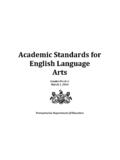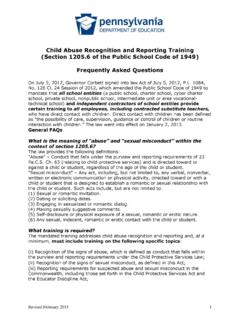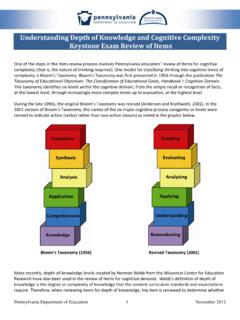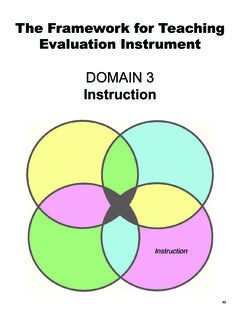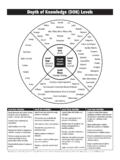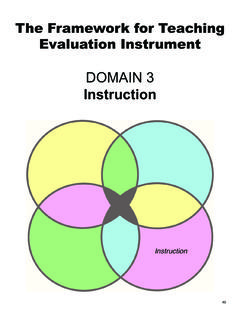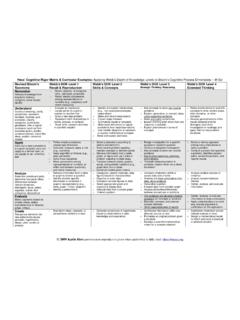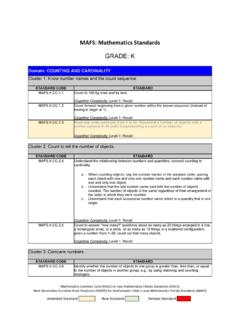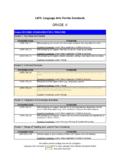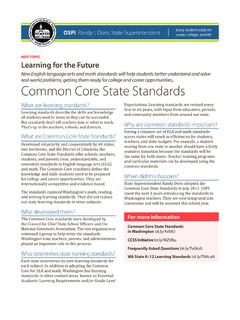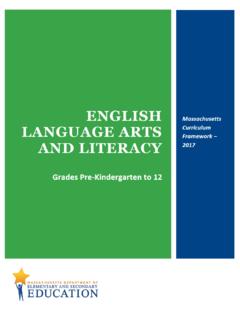Transcription of Academic Standards for Mathematics - pdesas.org
1 Academic Standards for Mathematics Grades Pre K High School March 1, 2014 Pennsylvania Department of Education PA core Standards Mathematics | P a g e2 March 1, 2014 INTRODUCTION The Pennsylvania core Standards in Mathematics in grades PreK 5 lay a solid foundation in whole numbers, addition, subtraction, multiplication, division, fractions, and decimals. Taken together, these elements support a student s ability to learn and apply more demanding math concepts and procedures. The middle school and high school Standards call on students to practice applying mathematical ways of thinking to real world issues and challenges; they prepare students to think and reason mathematically.
2 Additionally, they set a rigorous definition of college and career readiness by demanding that students develop a depth of understanding and ability to apply Mathematics to novel situations, as college students and employees regularly do. Although the Standards are not a curriculum or a prescribed series of activities, school entities will use them to develop a local school curriculum that will meet local students needs. This document includes PA core Standards for Mathematical Content and Mathematical Practice. The Mathematics Standards define what students should understand and be able to do. Mathematical Practice Standards describes the habits of mind required to reach a level of mathematical proficiency.
3 PA core Standards Mathematical Content and Mathematical Practice Standards for Mathematical Content Standards for Mathematical Practice Numbers and Operations A) Counting and Cardinality B) Numbers and Operations in Base Ten C) Numbers and Operations Fractions D) Ratios and Proportional Relationships E) The Number System F) Number and Quantity Make sense of problems and persevere in solving them. Reason abstractly and quantitatively. Construct viable arguments and critique the reasoning of others. Model with Mathematics . Use appropriate tools strategically. Attend to precision. Look for and make use of structure.
4 Look for and make sense of regularity in repeated reasoning. Algebraic Concepts A) Operations and Algebraic Thinking B) Expressions & Equations C) Functions D) Algebra Geometry A) Geometry Measurement, Data, and Probability A) Measurement and Data B) Statistics and Probability PA core Standards Mathematics | P a g e3 March 1, 2014 Standards cannot be viewed or addressed in isolation, as each standard depends upon or may lead into multiple Standards across grades; thus, it is imperative that educators are familiar with both the Standards that come before and those that follow a particular grade level.
5 These revised Standards reflect instructional shifts that cannot occur without the integrated emphasis on content and practice. Standards are overarching statements of what a proficient math student should know and be able to do. The Pennsylvania Assessment Anchors and Eligible Content closely align with the revised Standards and are an invaluable source for greater detail. Key Points in Mathematics The Standards stress both procedural skills and conceptual understanding to ensure students are learning and applying the critical information they need to succeed at higher levels. K 5 Standards , which provide students with a solid foundation in whole numbers, addition, subtraction, multiplication, division, fractions, and decimals, help young students build the foundation to successfully apply more demanding math concepts and procedures, and move into application.
6 They also provide detailed guidance to teachers on how to navigate their way through topics such as fractions, negative numbers, and geometry, and do so by maintaining a continuous progression from grade to grade. Having built a strong foundation at K 5, students can do hands-on learning in geometry, algebra, and probability and statistics. Students who have mastered the content and skills through the seventh grade will be well-prepared for algebra in grade 8. High school Standards emphasize practicing applying mathematical ways of thinking to real world issues and challenges. PA core Standards Mathematics | P a g e4 March 1, 2014 The PA core Standards for Mathematics detail four standard areas: Numbers and Operations, Algebraic Concepts, Geometry, and Measurement, Data, and Probability.
7 These standard areas are reflective of the reporting categories in the PA core Assessment Anchors and Eligible Content. The intent of this document is to provide a useful tool for designing curriculum, instruction, and assessment. The grade level curriculum and instructional shifts in Mathematics cannot occur without the integrated emphasis on content and practice. The chart below illustrates the four standard areas and the development and progression of the strands, with an understanding that all is framed around the Standards for Mathematical Practice. Mathematical Standards : Development and Progression Standards for Mathematical Practice Make sense of problems and persevere in solving them.
8 Construct viable arguments and critique the reasoning of others. Use appropriate tools strategically. Look for and make use of structure. Reason abstractly and quantitatively. Model with Mathematics . Attend to precision. Look for and express regularity in repeated reasoning. PreK K 1 2 3 4 5 6 7 8 HS Numbers and Operations (A) Counting & Cardinality (B) Numbers and Operations in Base Ten (D) Ratios and Proportional Relationships (F) Number and Quantity (C) Numbers and Operations Fractions (E) The Number System Algebraic Concepts (A) Operations and Algebraic Thinking (B) Expressions and Equations (D) Algebra (C) Functions Geometry (A) Geometry Measurement, Data, and Probability (A) Measurement and Data (B)
9 Statistics and Probability PA core Standards Mathematics | P a g e5 March 1, 2014 Numbers and Operations The Standards of Mathematical Practices Make sense of problems and persevere in solving them. Reason abstractly and quantitatively. Construct viable arguments and critique the reasoning of others. Model with Mathematics . Use appropriate tools strategically. Attend to precision. Look for and make use of structure. Look for and express regularity in repeated reasoning. Grade PreK Grade K Grade 1 Grade 2 Grade 3 Grade 4 Grade 5 Pennsylvania s public schools shall teach, challenge, and support every student to realize his or her maximum potential and to acquire the knowledge and skills needed to: (A) Counting & Cardinality Know number names and the count sequence.
10 Know number names and write and recite the count sequence. Intentionally Blank Intentionally Blank Intentionally Blank Intentionally Blank Intentionally Blank Count to tell the number of objects. Apply one-to-one correspondence to count the number of objects. Compare numbers. Apply the concept of magnitude to compare numbers and quantities. (B) Numbers & Operations in Base Ten Intentionally Blank Use place value to compose and decompose numbers within 19. Extend the counting sequence to read and write numerals to represent objects. Use place-value concepts to represent amounts of tens and ones and to compare three digit numbers.


